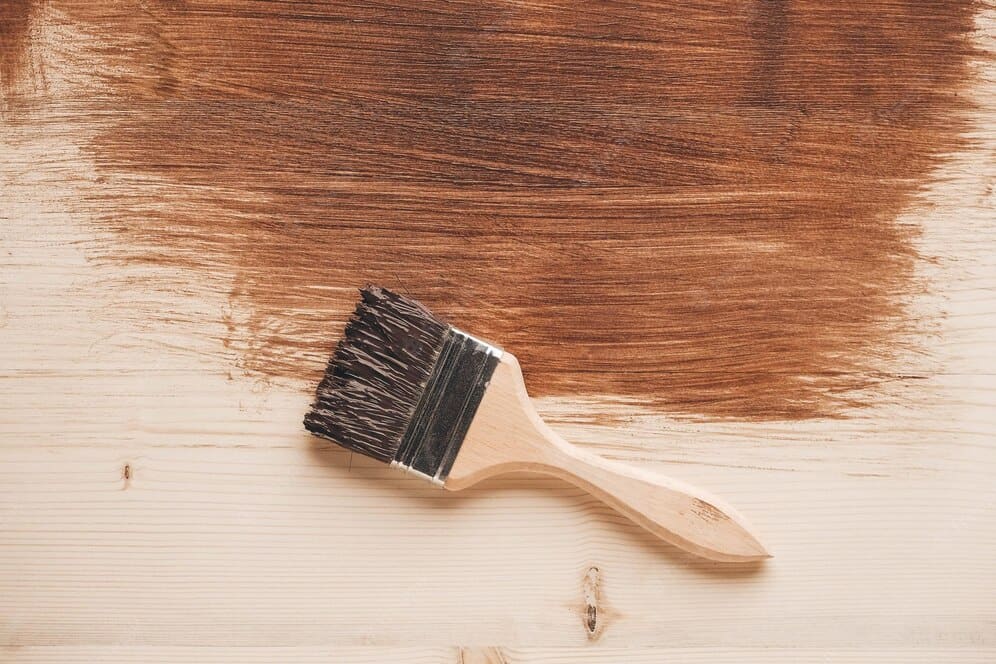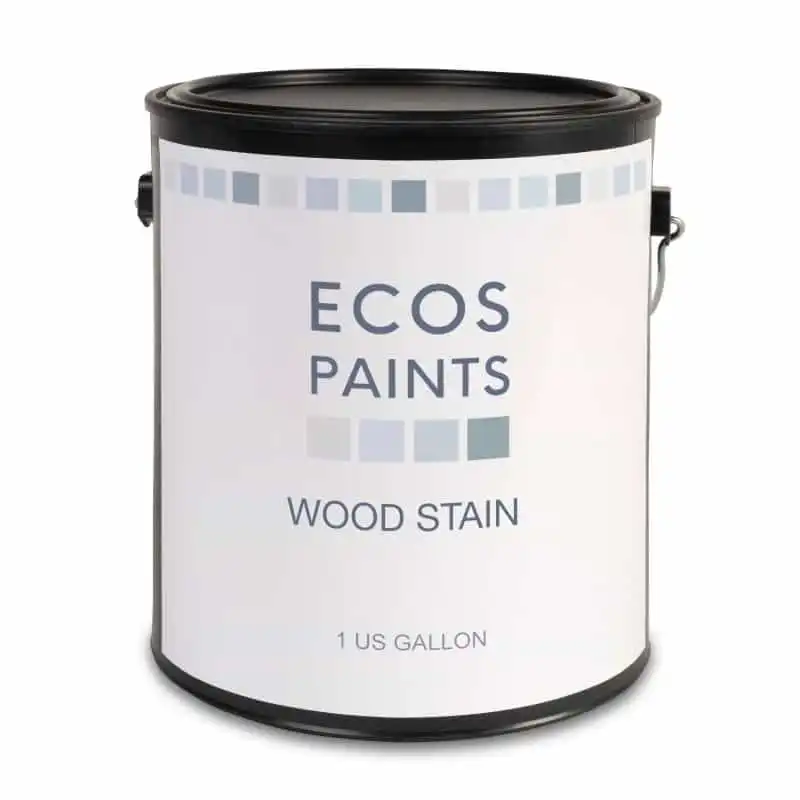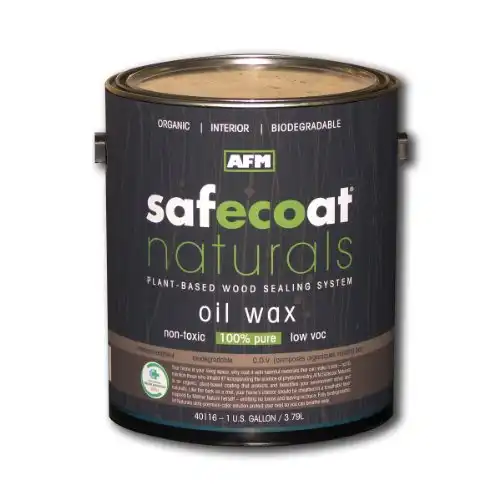- You are here:
- Home »
- Nontoxic Furniture »
- Is Wood Stain Toxic?
Is Wood Stain Toxic?
When it comes to wood stain, there are a lot of different options out there, some of them are toxic while others are completely safe. You can choose between oil-based and water-based stains, each with its own set of pros and cons. But whichever type of wood stain you choose, it’s important to be aware of the dangers of toxic fumes.
Wood stain is a great way to revitalize old wooden furniture and floors, but many people aren’t aware of the dangers that can come with using it. In this article, we’ll be taking a closer look at the dangers of wood stain fumes, and how you can protect yourself from them.

What Are the Dangers of Wood Stain Fumes?
Wood stains may contain toxic ingredients, such as petroleum, alcohol, formaldehyde, sodium hydroxide, and glycol ether. These ingredients can cause a variety of negative health effects when they are inhaled or otherwise come into contact with the body. Symptoms can include breathing issues, nausea, dizziness, irritation of the eyes and throat, headaches, and more.
When painting or staining wood indoors, it is important to take steps to protect yourself from harmful fumes. This can be done by using proper ventilation and wearing protective gear, such as a respirator or face mask.
Once the wood stain dries, it can still release harmful VOCs into the air, which can linger for days or even months. The most toxic types of wood stain are those that contain high levels of VOCs, such as oil-based stains.
What Are The Ingredients In Oil-Based Wood Stains?
The ingredients in oil-based wood stains vary, but they often include petroleum, alcohol, formaldehyde, sodium hydroxide, and glycol ether. When these chemicals are inhaled or otherwise come in contact with the body, they may cause a variety of negative health effects.
How to Handle Wood Stain Fumes?
When painting or staining wood indoors, it is important to take steps to protect yourself from harmful fumes. This can be done by using proper ventilation and wearing protective gear, such as a respirator or face mask.
In order to protect yourself from wood stain fumes, it is important to use proper ventilation when working with stains or paints indoors. This can include opening windows or doors, or using an exhaust fan.
It is also important to wear protective gear, such as a respirator or face mask, when working with wood stains or paints. This will help to protect you from inhaling harmful fumes.
If you are concerned about the safety of a particular wood stain or paint, it is best to check with the manufacturer to see what precautions they recommend when using their products. By taking these steps, you can safely work with wood stains and paints indoors without exposing yourself to unwanted fumes.
After the wood stain dries, you should still ventilate the area until the smell is no longer present. You can also use an air purifier to help remove any lingering fumes. Air purifiers with HEPA filters are ideal for this purpose, as they can help remove a wide range of harmful particles from the air.
Overall, it is important to be aware of the potential dangers of wood stains and paints when using them indoors, and to take steps to protect yourself from any harmful fumes or particles.
Is It Possible To Find Non Toxic Wood Stain?
If you´re looking for a wood stain that doesn´t contain toxic chemicals, then you´re in luck. There are actually a lot of options available out there these days that are free from the harmful chemicals found in many other stains on the market today. Take a look at the products below and see if any of them fit your needs.
ECOS Wood Stain
ECOS Wood Stain is a great way to change the color of your wood while still allowing the natural grain to show through. The stain is available in several pre-mixed colors, so you can find the perfect shade for your project.
The tinted finish requires a clear varnish topcoat, but the non-toxic, VOC-free formula provides long-lasting protection without the harsh chemicals or odors found in conventional paints. You can use ECOS Wood Stain on both interior and exterior surfaces, making it a versatile option for any project.
With its easy application and wide range of colors, ECOS Wood Stain is the perfect way to update your home without compromising on quality or safety.
Natural Oil Wood Finishes
Although there are many synthetic options on the market, natural oil wood finishes are becoming increasingly popular. Not only are they non-toxic and safe for both you and the environment, but they can also provide a beautiful, natural finish to your woodwork.
Linseed oil and castor oil are two of the most commonly used oils for this purpose. To apply, simply wipe the oil onto the surface of the wood using a clean cloth. Allow it to soak in for a few minutes, then wipe away any excess.
You may need to apply several coats in order to achieve the desired level of saturation. Once you’re happy with the results, enjoy your beautiful, natural finish!
AFM Naturals Wood Stain
This low-VOC plant-based hardener and sealer works well on all types of wood, including bamboo and cork, and it’s also safe to use on children’s furniture and toys. AFM Naturals Wood Stain has a sophisticated blend of natural resins and waxes, creating a durable, water-repellant finish that helps to protect the wood from water damage and stains.
Plus, it’s free of lead, cobalt and citrus drying compounds. So if you’re looking for an eco-friendly way to seal and protect your wood surfaces, this hardener and sealer is a great choice!
Read More: Solid Wood vs. Composite Wood
Homemade Non Toxic Wood Stain Solutions
DIY natural wood stains are easy to make and much safer for both you and the environment. You can create natural wood stains using items like red wine, tea or coffee. While they will tint the wood a bit, they will not provide as much color as chemical-based stains.
Apart from that, they don´t have water sealing properties, so they can´t be used outdoors. Still, these natural wood stains are a great way to add some subtle color to your woodworking projects.
FAQs
1) Is wood stain safe?
Wood stains typically contain volatile organic compounds (VOCs), which can be harmful to human health. VOCs are released into the air when the stain is applied, and can be inhaled. Some common VOCs in wood stains include toluene, xylene, and methylene chloride. These chemicals have been linked to a variety of health problems, including headaches, dizziness, and respiratory problems.
3) How can I avoid exposure to wood stain toxins?
When using wood stains, it is important to work in a well-ventilated area. If possible, open windows and doors to allow fresh air to circulate. It is also important to wear gloves and a mask to avoid direct contact with the chemicals.
4) What are the long-term health effects of exposure to wood stain toxins?
Exposure to VOCs has been linked to a variety of health problems, including cancer, liver damage, and kidney damage. Long-term exposure to wood stains can also cause neurological problems, such as memory loss and difficulty concentrating.
5) Can I remove wood stain from my skin?
If you’ve ever gotten wood stain on your skin, you know it can be a real pain to get rid of. But don’t worry – there are a few household ingredients that can help. Rubbing alcohol or isopropyl alcohol will break down the wood stain, making it easier to remove. Just soak a clean rag in a bowl of the solvent and rub the stained skin until the stain disappears.
Acetone can also be effective, but it’s important to use it sparingly as it can be drying to the skin. Once the stain is gone, rinse the area with lukewarm water and soap. And remember – always wear gloves when working with wood stain to avoid this problem in the first place!
6) Can I remove wood stain from my clothing?
Removing a wood stain from clothing can be easy if you know what to do. First, mix together one teaspoon of liquid dishwashing detergent and one-fourth cup household ammonia with two cups of warm water. Next, dip a clean white cloth or sponge into the solution and gently blot the stained area.
You may need to do this several times to remove the stain completely. Finally, rinse the area with cold water and allow the clothing to air dry. If the stain is still visible, you can try repeating these steps or taking the clothing to a professional cleaner.
7) How can I protect my family from exposure to wood stain toxins?
If you are using wood stains in your home, it is important to take precautions to protect your family from exposure. Make sure to work in a well-ventilated area and wear gloves and a mask. Also, be sure to wash your hands thoroughly after working with the stains.
If you have children, keep them away from areas where you are using wood stains. Your best bet is to use zero or low-VOC stain or natural oil finishes. These products are safe for your family and the environment.
8) What should I do if I accidentally ingest wood stain?
If you accidentally ingest wood stain, it is important to seek medical attention immediately. When bringing the person to the hospital, it is helpful to bring the wood stain container with you so that doctors can determine which chemicals may have been ingested. Do not try to treat the person at home and never induce vomiting.
Read More: Is MDF Toxic?
Conclusion
Now that we know a little more about wood stains and their toxicity, let’s answer the question: are wood stains toxic? The simple answer is: it depends. Some wood stains are more toxic than others, and some are even considered to be non-toxic.
It really just depends on the ingredients used in the stain. If you are concerned about the toxicity of wood stains, be sure to read the labels carefully and choose a product that is low in VOCs or made with natural ingredients. You can also try making your own non-toxic wood stain at home. And, as always, use caution when working with any type of chemical.
Still have questions? Leave us a comment below and we’ll do our best to answer them!
Read More: Best Non Toxic Furniture Brands
About the Author Kamila Flieger
My name is Kamila, and I'm passionate about researching non-toxic, organic products for the home. I believe it's so important to create a safe and healthy environment for our families, and I enjoy helping others do the same.




